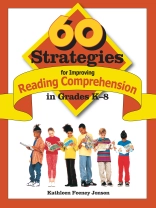Use these fun, easy-to-use activities to tackle the most challenging aspect of reading!
‘Finally, someone has written a practical book filled with easy-to-read comprehension strategies. I will definitely use this book with teachers in my district to teach about and review comprehension strategies. The section on ′How Can We Learn More′ is also fantastic. Thank you, Kathleen Jonson.’
–Hazel Brauer, Literacy Coordinator
Jefferson Elementary School District, Daly City, CA
‘This book is a comprehensive, well-organized guide to teaching reading comprehension. The clear, consistent layout of the lesson plans makes it easy for the teacher to locate and implement appropriate lessons quickly. The examples are very helpful and the templates allow a teacher to begin lessons immediately. The wide variety of lesson plans makes this guide truly useful for all grade levels.’
–Myra Gamble, Reading Specialist
Spring Valley School, Millbrae, CA
Comprehension is the final goal of reading, but because it involves several cognitive processes, it remains the most difficult facet of reading development to teach. Based on the recommendations of the National Reading Panel Report, 60 Strategies for Improving Reading Comprehension in Grades K-8 provides teachers with a ready-to-use toolkit of tried-and-true learning strategies designed to actively engage students in cognitive processes, including predicting, visualizing, making inferences, monitoring, synthesizing, and summarizing. Developed as specific instructional procedures with clearly delineated steps for implementation, these entertaining activities are effective in all types of classrooms. Each of the 60 strategies in the book includes:
- Grade-level recommendations
- Goals for each strategy
- Step-by-step instructions
- Graphics and examples of student work
- Directions for modifying strategies for different grade levels
Literary expert Kathleen Feeney Jonson has created an exciting resource to help educators teach the most difficult piece of the reading process: comprehension. Offering a rare combination of fun and function, these strategies are sure to get students to listen, laugh, and most important, to learn.
Tabla de materias
Preface
About the Author
Strategy 1: ABC Book
Strategy 2: Anticipation Guide
Strategy 3: Bio Poem
Strategy 4: Book Box
Strategy 5: Brainstorming
Strategy 6: Bumper Stickers
Strategy 7: Central Story Problem
Strategy 8: Character Bag
Strategy 9: Character Mapping
Strategy 10: Creating Chapter Titles
Strategy 11: Crossword Puzzle
Strategy 12: Cubing
Strategy 13: Directed Reading Thinking Activity
Strategy 14: Double-Entry Journal
Strategy 15: Exclusion Brainstorming
Strategy 16: Fishbowl
Strategy 17: Found Poem
Strategy 18: Four-Corners Debate
Strategy 19: Gallery Walk
Strategy 20: Grand Conversation
Strategy 21: Guided Imagery
Strategy 22: Hot Seat
Strategy 23: Interior Monologue
Strategy 24: Jigsaw
Strategy 25: K-W-L Chart
Strategy 26: Learning Logs
Strategy 27: Life Experience
Strategy 28: Literacy Quilt
Strategy 29: Literacy Sociogram
Strategy 30: Literature Circles
Strategy 31: Mind Mapping
Strategy 32: Open Mind Character Analysis
Strategy 33: Paired Retellings
Strategy 34: Pick-A-Pal
Strategy 35: Plot Profile
Strategy 36: P-M-I Evaluation (Pluses-Minuses-Interesting Aspects)
Strategy 37: Quaker Reading
Strategy 38: Question-Answer Relationships
Strategy 39: Questioning the Author
Strategy 40: Quickwriting
Strategy 41: Readers′ Theater
Strategy 42: Read-Pair-Share
Strategy 43: Reciprocal Questioning (Re Quest)
Strategy 44: Response Log
Strategy 45: Semantic Mapping
Strategy 46: Sketch-to-Stretch
Strategy 47: SQ3R (Survey-Question-Read-Recite-Review)
Strategy 48: Stop-and-React
Strategy 49: Storyboard
Strategy 50: Story Frame
Strategy 51: Story Mapping
Strategy 52: Story Prediction Guide
Strategy 53: Story Pyramid
Strategy 54: Summary Hand
Strategy 55: Tableau
Strategy 56: Tea Party
Strategy 57: Think-Aloud Protocol
Strategy 58: Think-of-Three
Strategy 59: Venn Diagram
Strategy 60: Yellow Stickies
Resource I: Strategies Recommended by Grade Level
Resource II: Elements Addressed Through Strategies
Resource III: Strategies Used Before, During, and After Reading
Resource IV: Meta-Strategies Addressed
Index
Sobre el autor
In her 40 years as an educator, Kathleen Feeney Jonson, Professor Emeritus, has been a teacher, taught director of staff development, principal, director of curriculum and instruction, and university faculty. She conducted numerous workshops for teachers and administrators on such topics as reading comprehension strategies, writing process, portfolio assessment, peer coaching, and beginning teacher assistance programs. Until her retirement in summer 2009, Jonson was professor of education and coordinator of the Master in Arts in Teaching Reading program at the University of San Francisco′s School of Education. She published three books with Corwin Press, including The New Elementary Teacher′s Handbook (1st edition 1997, 2nd edition 2001), Being an Effective Mentor: How to Help Beginning Teachers Succeed (1st edition 2002, 2nd edition 2007), and 60 Strategies for Improving Reading Comprehension in Grades K–8 (2006).












